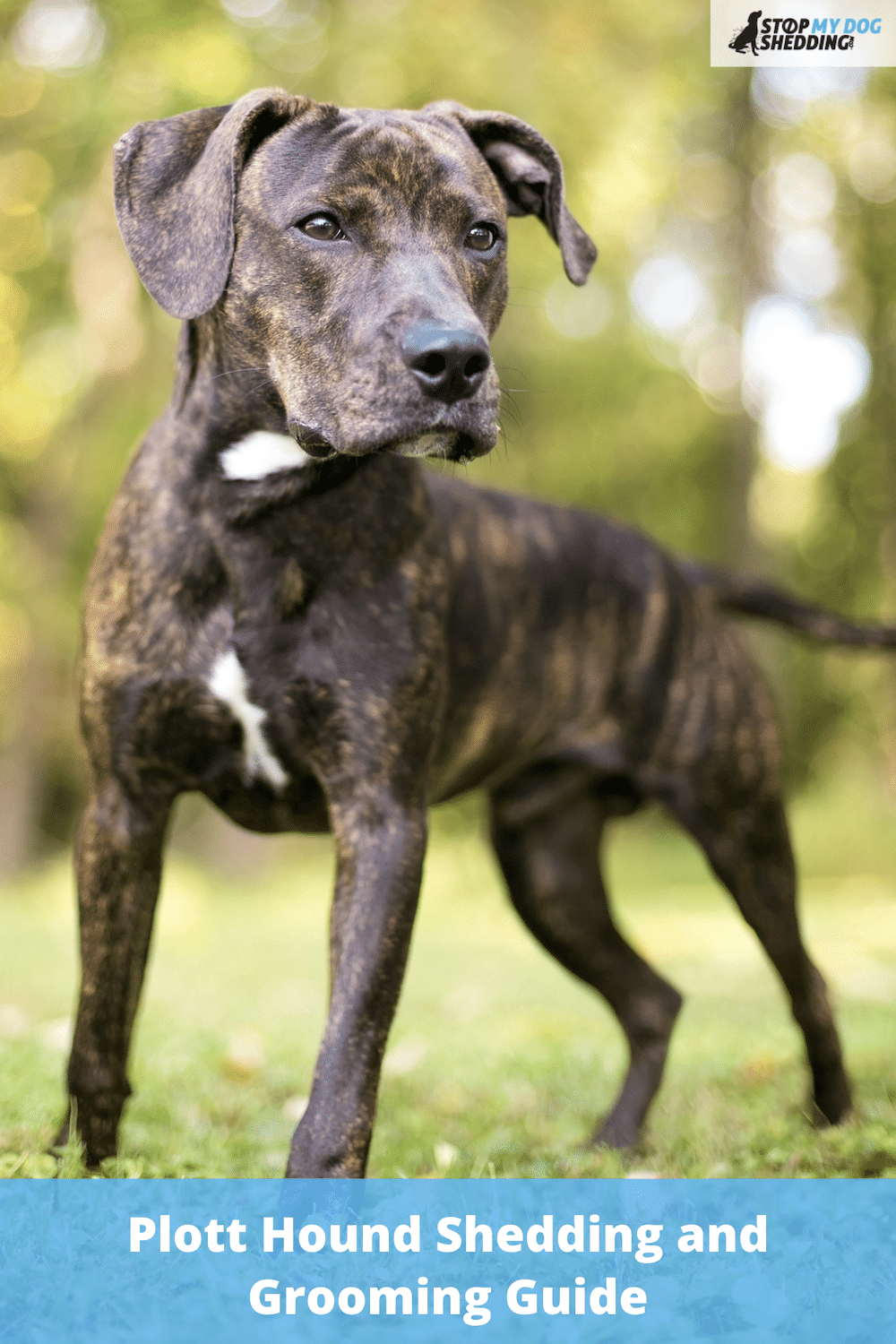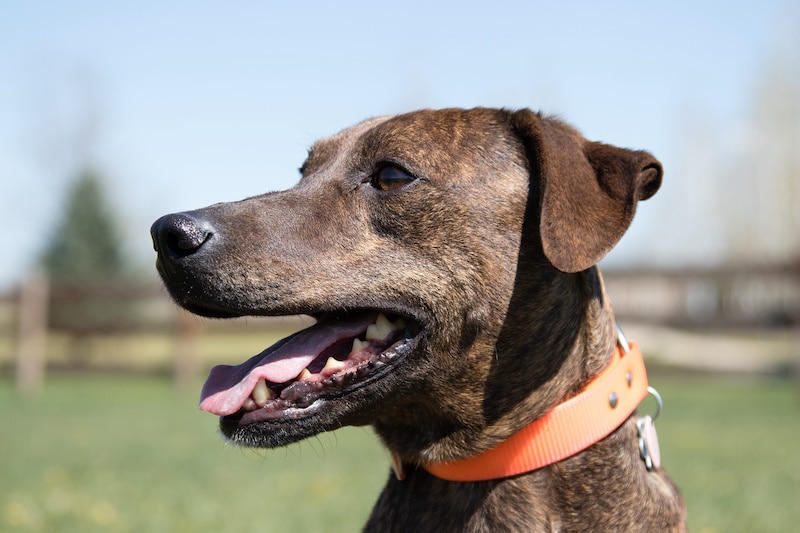The Plott Hound is a full-sized Scent Hound that was originally bred to hunt bears. The canine officially became North Carolina’s state dog in 1989 and still is to this day. With a whole lot to love, you may wonder if the Plott Hound is the right dog for you.
I’ll go into more detail on the breed’s background and traits towards the end of the post. But first, let’s start by discussing Plott Hound shedding.
The Plott Hound is typically low-shedding, but this breed can have a single or double coat, and the shedding can be more noticeable if you have the rarer double-coated variety. Either way, keeping this dog groomed is exceptionally easy thanks to its short fur.
In this guide, all your most burning questions about the Plott Hound will be answered, including how often this dog sheds, how difficult they are to groom, and whether the Plott Hound is hypoallergenic or not. Then, I’ll give you some insight into the breed’s heritage.
So with all that said, let’s get started!
Plott Hound Shedding Guide
Most dogs are single-coated or double-coated with no variations. However, that’s not quite the case with the Plott Hound, and that’s why this dog’s shedding habits are either low or moderate.
Before we get into how many layers of fur the Plott Hound has, let’s go over the basics of this breed’s coat.
The Plott Hound has a close-cropped coat. Its short fur comes in a variety of colors ranging from black to blue, brown, gray, red, brown, yellow, orange, and brindle.
If you’ve read this blog before, then you’ll recall how short-furred dogs usually shed more than their longer-furred counterparts.
The reason? The dog hair growth cycle.
This four-stage cycle repeats across a dog’s life. During the anagen phase, new hair begins to grow. In catagen, the hair gets as long as it will grow and then stops.
The telogen phase is a resting phase while the exogen phase is when a dog’s hair sheds.
A longer-coated dog takes much longer to get through anagen, catagen, and telogen. By the time exogen happens, they’re not shedding heaps.
Short-haired dogs such as the Plott Hound rush through the fur growth stages since their hair never grows that long in the first place.
Plotts are smooth-coated as well, lacking the wiry coat that would reduce this breed’s shedding even further.
Okay, so now let’s finally talk about single-coated versus double-coated Plott Hounds.
As I mentioned in the intro, most Plott Hounds have one coat. This means that you’ll experience some shedding throughout the year from your dog, but the rate of shedding shouldn’t change.
If it does, then it may be worth consulting your vet, as it could be an issue with your Plott’s diet, a flea infestation, or any number of potential health issues.
Shedding is normal among almost all dogs, so it’s usually nothing to be concerned about. But if you’re noticing sudden, excessive, or patchy hair loss and redness on the skin, for example, that may be when a visit to the local veterinarian could be worthwhile.
For those dog owners with the rarer double-coated Plott Hound, this dog will blow its coat twice per year. So if you’re noticing excessive shedding once or twice a year, that may be why.
In the summer, the Plott ramps up its rate of shedding, losing its thicker coat so it can stay cool. This shedding period can last for weeks even after your dog has transitioned into a newer, lighter coat.
Then in the winter, your Plott typically blows its coat a second time. The fur that grows back will be thicker to withstand the colder temperatures.
Recommended: Go here to see our top-rated dog hair blow dryers
Grooming Your Plott Hound
If there’s one advantage of smooth, short coats, it’s that they’re exceptionally easy to groom.
I’d recommend a rubber curry glove or even a hand glove for brushing your Plott Hound’s coat.
Brushing your dog is highly beneficial in a variety of ways. You’ll pull out loose hairs from your Plott before they can come out on their own, controlling how much your dog sheds.
You’re also spreading skin oils across your dog’s body to keep their skin moisturized.
Oh, and using a rubber brush on a short-haired breed like the Plott is going to feel great, like receiving a relaxing massage!
Even double-coated Plott Hounds aren’t prone to knotted and tangled fur due to the length of their coats, so brushing the dog will be a quick affair.
I would suggest combing your Plott every day or two if yours is a double-coated dog undergoing seasonal shedding spikes. At any other time of the year (or anytime for single-coated Plotts), brushing your pup once or twice per week is generally sufficient.
How often do you have to bathe your Plott Hound? Well, brushing should rid the top layer of the fur of any surface dirt, which will keep your pup cleaner for longer.
Most Plott owners wait to bathe their dogs until they begin to smell or are visibly dirty, such as after taking a romp in a mud puddle or a dog park.
When bathing your Plott Hound, it’s best to use dog-friendly shampoo.
Be sure to rinse away all residue so you don’t irritate the dog’s skin. The irritation could lead to scratching which will exacerbate shedding.
You can towel-dry your Plott or allow him to air-dry. Since the dog doesn’t have very long fur, neither option takes long!
An active Plott Hound will have worn-down nails. If your Plott isn’t getting outside so often these days, such as in the wintertime, feel free to trim the dog’s nails yourself or take your pup to a groomer.
About once a month, or even twice a month if you want to be extra diligent, check your Plott’s ears. You’re looking for an accumulation of earwax or debris that could obstruct the dog’s hearing.
Since the Plott has drop ears (ears that lay flat against the head), without these frequent checks, you could miss ear symptoms until they become painful for your dog.
Are Plott Hounds Hypoallergenic?
One of the most frequent questions that come up when looking into different dog breeds to adopt is whether the breed is hypoallergenic.
Allow me to explain for a moment that no dog is hypoallergenic if your definition of a hypoallergenic dog is a canine that prevents allergy symptoms altogether.
The reason for that is pet allergy sufferers are allergic to pet dander, not pet fur. Dander is dead skin that can travel with fur, so the more a dog sheds, the worse one’s allergy symptoms usually are.
Hypoallergenic dogs only reduce allergy symptoms, not stop them altogether.
For a dog to fit the bill of hypoallergenic, it must be low-shedding. Plott Hounds and their variable rates of shedding simply don’t fit the bill.
Further, hypoallergenic dogs are usually small. The smaller your canine companion, the less dog there is to shed dander, fur, the whole nine.
Plotts are anything but small. The average size of this breed is 20 to 25 inches tall and up to 60 pounds.
Thus, Plott Hounds are not hypoallergenic.
About Plott Hounds: Should You Adopt?
The Plott Hound’s hypoallergenic status aside, you may still be trying to make up your mind about whether you should adopt a Plott Hound. Allow this section to be your guide.
The Plott Hound is a large dog with exceptional scent skills. The dog earned its name after Johannes “George” Plott, a German immigrant who came to North Carolina. The Plott family led to the breeding of what became the modern-day Plott Hound.
An agile hunter that used to take down bears in Germany, the Plott is brave, smart, alert, and very loyal.
Living with a Plott in an apartment is probably not the best idea. You already know how large this dog can be, so an apartment might be too cramped for the Plott Hound.
Plotts have an abundance of energy and are rigorous athletes with endless amounts of determination, agility, endurance, and stamina. They need a place to put that on display, such as a large, fenced-in yard or a nearby park.
Just be ready to play or walk for a while, as it takes a lot of exercise to tire out a Plott Hound!
As a pack breed, the Plott should assimilate rather well with the other four-legged canine members of your family. It’s even recommended that this breed live with other dogs than on its own. That said, you must socialize your Plott Hound to your canines.
Plott Hounds have an exceptionally high prey drive. If you want to raise them with smaller animals such as cats or hamsters, you need to do it when your Plott is young.
Even then, that only guarantees that your own cat will be safe. If you’re walking your Plott Hound and the dog sees another small creature, the Plott will try to hunt.
As a gentle family dog, the Plott is a natural companion of children but still needs socialization.
Plotts are very vocal canines and bark quite loudly. The dog is an attention seeker and will bark out of boredom. Some Plott owners say this breed kind of talks with its vocalizations.
Here’s an informative YouTube video I found if you want to know more about this breed:
Final Thoughts
The Plott Hound is a large dog of German origin who used to hunt bears. That belies his sweet personality and loyalty towards people.
Plotts shed moderately to more ferociously depending on whether yours is a single-coated or double-coated breed.
Regular grooming, especially when your Plott begins shedding seasonally, will prevent this dog’s short fur from floating all over the house.
Although not the most conventional companion, if you have room in your heart for a Plott Hound, you won’t be disappointed!













Please note: By submitting a comment using the above comment form, you confirm that you agree with the storage and handling of your data by this site as detailed in our Privacy Policy.